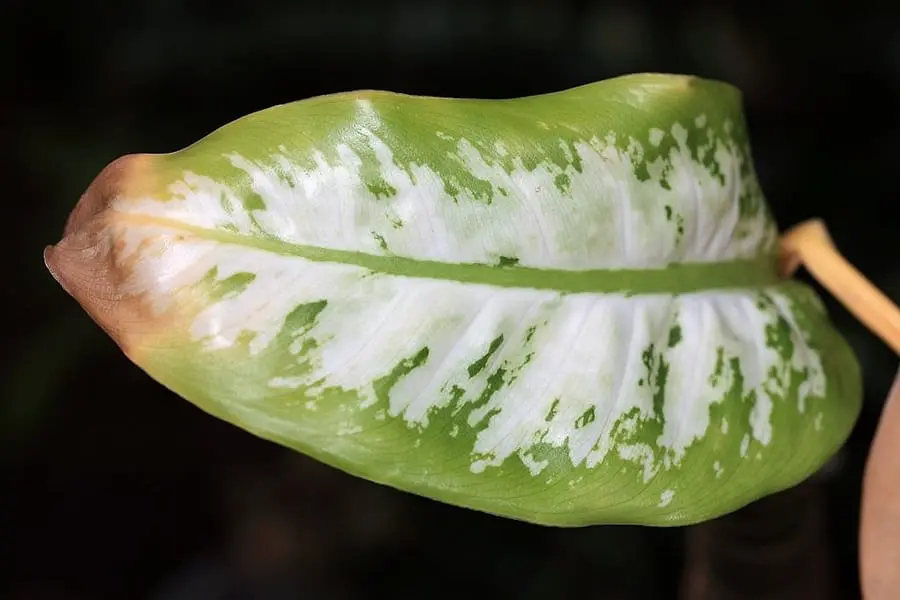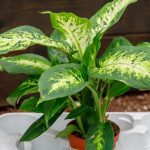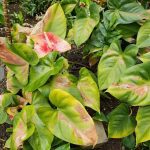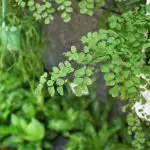
Dieffenbachia is one of the easiest houseplants to grow, but can sometimes have problems with yellow, droopy leaves. When we first started growing this plant – commonly known as dumb cane – we also had this issue. Here’s what we learned and how we fixed it.
So, how can you help a dieffenbachia with yellow, droopy leaves? Allow the surface of the soil to dry out before watering again. Overwatering is the most common cause of yellowing and dropping leaves. Next, make sure the plant is getting bright, indirect sunlight and the temperature is above 59 degrees F (15 degrees C).
There are several reasons that your dieffenbachia might be experiencing discoloration or losing leaves. Let’s look at the most common problems and how to fix them.
Normal Growth
Dieffenbachia’s lower leaves may droop and turn yellow as part of the normal growth pattern. When this happens, simply remove the drooping leaves by pinching or cutting them off.
You only need to worry when you experience excess yellowing or drooping of the upper leaves. If you see this happening, refer to the troubleshooting tips below. The main culprits include:
- Overwatering
- Too Much Sunlight
- Low Temperatures
- Nutrient Deficiencies
- Root Bound Plants
- Pest Infestation (Less Common)
Overwatering
Dieffenbachia will not tolerate frequent overwatering. For the best results, water the plant thoroughly, and then wait until the potting soil is dry to the touch before watering again. This method is sometimes called “drench then dry.”
Never allow dieffenbachia to become waterlogged. Too much water will cause leaves to turn yellow, droop, and eventually drop off all together. Root rot will also be a problem in waterlogged plants. Make sure your pot has a drainage hole in the bottom (that isn’t blocked) to avoid standing water.
Learning to properly water your plant is more art than science, but you’ll get a feel for it after a while. If you can insert your finger into the soil and it’s dry to your first knuckle, the plant needs water.
Avoid both over- and under-watering for dieffenbachia to thrive.
Too Much Sunlight
Dieffenbachia can grow in heavy shade, but too much sunlight can cause the leaves to turn yellow and droop. As tropical plants, they’re adapted to life on the forest floor – where it’s shady and not too hot.
The plant thrives in bright, indirect light – although it can also survive in dark areas of your home with slower growth. Placing the plant in direct or full sunlight will scorch the leaves.
If you suspect your dieffenbachia is getting too much sun, move it to a north- or east-facing window. Or if necessary, move it a few feet back from the window to filter some of the light.
Never grow dieffenbachia in a south-facing window, as it will provide too much sunlight for this tropical plant.
Low Temperatures
Consistently low temperatures or sudden changes in temperature will cause dieffenbachia leaves to droop and turn yellow. The plant grows best at temperatures between 65 and 75 degrees F (18 – 24 degrees C).
Never allow temperatures to drop below 59 degrees F (15 degrees C). If the leaves droop and fall off without yellowing first, this is often a sign that the temperature is too cold.
Even a drafty area of the home can adversely affect dieffenbachia. Make sure temperatures are warm and consistent wherever your plant lives. If you suspect your plant is too cold, move to a warmer window or area of the home not susceptible to drafts.
Nutrient Deficiencies
Failure to provide your dieffenbachia with essential nutrients may cause leaf yellowing – also known as chlorosis. According to the University of Illinois Extension, nutrient deficiencies may occur due to insufficient amounts or nutrients in the soil or unavailability due to high soil pH.
So how do you fix it? First, make sure your plant lives in the proper potting medium. Dieffenbachia performs best in one of the following:
- Pure peat moss
- 1:1 peat moss and perlite
- 1:1 potting soil and peat moss
- 1:1:1 potting soil, peat moss, and perlite
Once you have the correct potting medium, make sure you feed your plant adequately – but not too much. Dieffenbachia needs a complete houseplant fertilizer – such as 20-20-20 – applied once every four to six weeks during active growth.
Plants grown in low light require less frequent feeding – maybe once every 8-10 weeks.
Click here to see our favorite houseplant fertilizer on Amazon. We’ve used it for years with success on our dieffenbachia and other foliage plants.
After applying fertilizer, foliage should appear greener within three to four days. If you don’t notice a change, lack of nutrients may not be the problem.
Root Bound Plants
Dieffenbachia is especially prone to becoming root bound – along with other woody plants like rubber plant and dracaena. When plants have extensive root development and remain in a too-small pot, leaves may yellow, droop, and drop.
How do you know if your plant is root bound? You’ll notice roots are growing out of the drainage hole or even up through the top of the soil. Root bound means that the roots have completely taken up the space in the pot – i.e. the root system is too large for the growing container.
Rootbound plants have roots that form a dense ball and keep the shape of the pot when lifted out.
Repot rootbound dieffenbachia immediately in a larger container. You can also divide the plant and repot into smaller containers. After planting in a suitable container and potting medium, water thoroughly and fertilize. Your plant should return to its former beauty soon.
Pest Infestation
A less common cause for yellow and droopy leaves is severe infestation of mites or aphids. Inspect your plant thoroughly for pests. Webby material under the leaves with yellowing is a sign of spider mites, while aphids are easily seen crawling on the foliage.
If your plant is infested, first isolate it to prevent spreading to other houseplants. Treatment depends on the severity of the problem and the type of pest. For the best results, use an insecticidal soap according to the manufacturer’s directions to get rid of the pests.
In some cases, you may have to dispose of the plant completely if treatment does not get rid of the infestation.
Related Questions
Why does my Dieffenbachia have a yellow stem? Overwatering, low temperature, and too much sun can also cause the stem to turn yellow – similarly to the leaves. Allow the soil to become dry to the touch before watering, keep temperatures between 65 and 75 degrees F, and keep the plant in bright but indirect sunlight.
Should I remove yellow leaves? You can remove damaged or yellow leaves by gently pulling them off or snipping off with garden shears if they’re resistant. Never remove more than ⅓ of the plant’s leaves, and be careful not to damage the stem during removal. If the leaves yellow as part of the natural growth process, you can leave them on until they drop off on their own.
For more information, see our article on removing dying leaves from house plants.





